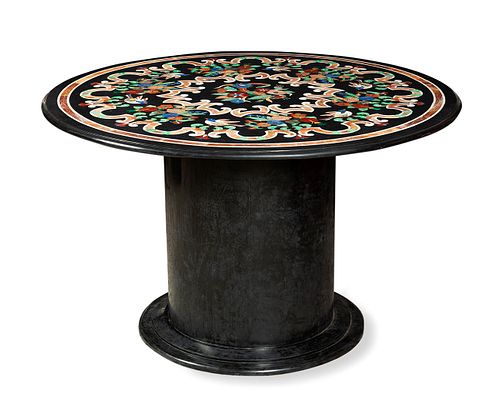Italian table, s.XIX. In black marble, hard stones and mother-of-pearl.
Lot 38
About Seller
Setdart Auction House
Carrer Aragó 346
Barcelona
Spain
Setdart Subastas was born in 2004 and is currently the first online art auction in Spain with solidity, prestige and reliability guaranteed by our more than 60,000 users. Setdart has a young, dynamic and enterprising team ready to successfully manage the purchase and sale of art works through custom...Read more
Categories
Estimate:
EUR€3,000 - EUR€3,500
$3,157.89 - $3,684.21
Absentee vs Live bid
Two ways to bid:
- Leave a max absentee bid and the platform will bid on your behalf up to your maximum bid during the live auction.
- Bid live during the auction and your bids will be submitted real-time to the auctioneer.
Bid Increments
| Price | Bid Increment |
|---|---|
| EUR€0 | EUR€10 |
| EUR€200 | EUR€25 |
| EUR€500 | EUR€50 |
| EUR€1,000 | EUR€100 |
| EUR€3,000 | EUR€200 |
| EUR€5,000 | EUR€500 |
| EUR€10,000 | EUR€1,000 |
| EUR€20,000 | EUR€2,000 |
| EUR€50,000 | EUR€5,000 |
About Auction
By Setdart Auction House
Oct 27, 2021
Set Reminder
2021-10-27 10:00:00
2021-10-27 10:00:00
America/New_York
Bidsquare
Bidsquare : 19th & 20th Century Paintings & Decorative Arts
https://www.bidsquare.com/auctions/setdart-auction-house/19th-20th-century-paintings-decorative-arts-7767
Setdart Auction House sofia@setdart.com
Setdart Auction House sofia@setdart.com
- Lot Description
Italian table, s.XIX. In black marble, hard stones and mother-of-pearl. Measurements: 71,5 x 121 x 121 cm. Italian table in black marble, with the top worked with inlaid mother-of-pearl and hard stones forming a refined inlay. In the sixteenth century, in Italy began to work the "hard stone", a technique of inlaying marble slabs whose origin is oriental (used both in goldsmithing and cabinetmaking in the Near East) but that in Florence acquired its own meaning. During the Baroque period it reached its peak of splendor and was still in use in the 20th century. In the table in question, entirely made of black marble, on a cylindrical foot of thick section rests a circular top, all decorated with inlays combining mother-of-pearl and hard stones: a floral bouquet presides over the center and from it radial compositions with floral bouquets and birds in different shades, separated by decorative bands like festoons. Carmine, yellow, amber, emerald and turquoise petals spread their colors to the exotic birds, studying the chromatic harmony to perfection. In Florence this technique later reached a high degree of perfection, to the point that the improper name of Florentine mosaic is given to all types of hard stone inlays. This work occupied the "Opificio delle pietre dure" from the Renaissance to the present day. The fame of the high quality of the products of the Florentine "Opificio" spread in the Baroque period throughout the European courts, often through gifts from the grand dukes themselves to the other sovereigns. Following the example of Florence, perhaps due to the presence of Florentine craftsmen, the various royal manufactories in Europe produced works of inlaid hard stones and marbles in France, Germany, Spain and Italy. In the eighteenth century the use of hard stones inlaid in marble spread everywhere, not only in Italy, but also in India in the Moghul period, where, on the preceding tradition of inlaid limestone and schist applied to architecture and black marble inscriptions inlaid in white marble, the influence of Florentine inlays is inserted.
- Shipping Info
-
In-house shipping available. Please inquire at admin@setdart.com.
-
- Buyer's Premium



 EUR
EUR CAD
CAD AUD
AUD GBP
GBP MXN
MXN HKD
HKD CNY
CNY MYR
MYR SEK
SEK SGD
SGD CHF
CHF THB
THB














